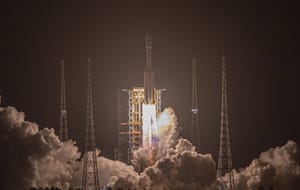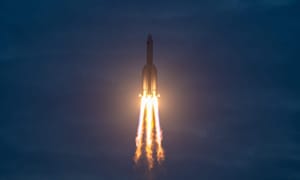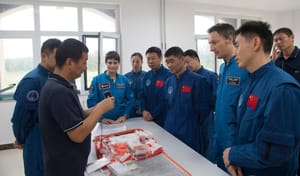
Jan 17, 2024
China launches sixth resupply mission to its space station
A Long March 7 lifted off from the Wenchang Space Launch Site on Wednesday the 17th of January at 22:27 pm Beijing Time. The rocket was carrying the Tianzhou 7 cargo spacecraft to low Earth orbit where it chased down the Tiangong Space Station.
The Tianzhou 7 docked to the Tianhe module at 02:07 am Beijing Time, on January 18th, where the Shenzhou 17 crew will access the spacecraft's cargo and use the extra room it provides for additional storage.

The Tianzhou 7 spacecraft is carrying supplies, clothing, and food to the space station to support the Shenzhou 17 and Shenzhou 18 missions. The spacecraft is also carrying 90 kilograms of fresh fruit onboard reportedly to boost moral during the six-month stay on the space station.
China's Tiangong Space Station is currently crewed by Tang Hongbo, Tang Shengjie, and Jiang Xinlin as part of the Shenzhou 17 mission.
Shenzhou 18 is believed to be launching in May of 2024 to take over from the Shenzhou 17 crew.

The Tianzhou spacecraft is an uncrewed cargo spacecraft developed by China to resupply the Tiangong Space Station. Tianzhou is derived from China’s first space station, Tiangong-1, and is capable of delivering 7,400 kilograms of cargo to their space station and weighs 14,000 kilograms.
The spacecraft does not possess any way to return cargo back down to Earth and is destroyed on re-entry. So far all Tianzhou spacecraft have been launched atop of the Long March 7 rocket. Tianzhou is also capable of transporting pressurized, semi-pressurized, and un-pressurized cargo. Current versions of the spacecraft are powered by two solar panels to generate electrical power for the spacecraft.

What is the Tiangong Space Station?
The Tiangong Space Station, also called the Chinese Space Station, is a permanently crewed space station in low Earth orbit operated by the China Manned Space Agency. The space station consists of the Tianhe core module, which was launched first on the 29th of April 2021, the Wentian laboratory module, which was launched second on the 24th of July 2022, and the Mengtian laboratory module, which was launched third on the 31st of October 2022. China currently plans to launch the Xuntian space telescope which will co-orbit with the space station for periodic docking for servicing and maintenance. There are also rumors of a fourth module that would allow up to six spacecraft to dock with the space station. The station currently has a pressurized volume of three hundred and forty cubic meters with one hundred and twenty-two cubic meters of it being habitable.

The Tianhe module functions as the core of the Tiangong space station and provides lift support and living quarters for three crew members. It also provides the guidance, navigation, and orientation control of the space station. Until the Wentian and Mengtian modules were docked it provided all of the space stations power. There is also an airlock to allow the crew to go on spacewalks outside the space station.
The Wentian module functions as a research laboratory in a microgravity, commonly called zero gravity, environment. It also has additional navigation avionics, propulsion, and orientation systems as a backup for the Tianhe module. The module also has a five-meter-long arm to assist with extra-vehicular activities and attach scientific instruments to one of the modules' twenty-two standard adapters on the outside of the module. Wentian also has two large solar arrays, which are one hundred and ten square meters each, to generate power for the space station. There is also another airlock to allow the crew to go on spacewalks outside the space station.
The Mengtian module functions as a microgravity, commonly called zero gravity, laboratory environment. The module also has a pair of experiment cargo doors to allow the experiments to be attached in a pressurized environment and then be moved outside without the need for extra-vehicular activities. Like Wentian, Mengtian has two large solar arrays, which are one hundred and ten square meters each, to generate power for the space station.



